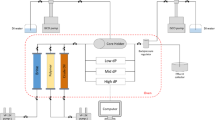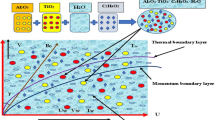Abstract
The study of biomimetics lattice structures, which frequently exhibit outstanding mechanical capabilities, is one of the hottest fields in modern new material/structural technology. The goal of this study is to analyze the nature optimize design of the Molluscs (Sea Shell) porous structure and bio-mimic the sea shell structure design for crashworthiness based on the structure’s energy absorption nature and pore distribution. Initially, a micro-CT investigation was conducted to better understand the internal design structure and distribution of pores in the Costapex gastropod mollusks sea shell. Based on the examination of internal design structure and pattern, three different biomimetics designs, such as (a) shell with solid betel shape (SBS) structure, (b) shell with hollow betel shape (HBS) structure, (c) shell with concentrated hollow betel shape (CHBS) structure, were modeled on Abaqus simulia software and fabricated by additive manufacturing by utilizing ABS-M30i material. The computational and experiments compressive analysis at 0.5%, 1%, and 10% strain rate were conducted to study its mechanical properties, while digital image correlation (DIC) was performed simultaneously to study the strain field of the design structures. Furthermore, the dynamic mechanical analysis (DMA) was performed at 0.5% strain rate at different frequency to study the viscoelasticity nature of the design structure and the various outcomes of the simulation, experimental, DIC, and DMA analysis are summarizing in results section.

















Similar content being viewed by others
Data availability
Data will be provided upon request.
References
Lam L, Chen W, Hao H, Li Z, Ha NS, Pham TM (2022) Numerical study of bio-inspired energy-absorbing device using shear thickening fluid (STF). Int J Impact Eng 162:104158. https://doi.org/10.1016/j.ijimpeng.2022.104158
Xu M, Zhao Z, Wang P, Duan S, Lei H, Fang D (2022) Mechanical performance of bio-inspired hierarchical honeycomb metamaterials. Int J Solids Struct 254–255:111866. https://doi.org/10.1016/j.ijsolstr.2022.111866
Hu J, Tan ATL, Chen H, Hu X (2022) Superior compressive properties of 3D printed plate lattice mechanical metamaterials. Int J Mech Sci 231:107586. https://doi.org/10.1016/j.ijmecsci.2022.107586
Liu Y et al (2021) Bioinspired fish-scale-like magnesium composites strengthened by contextures of continuous titanium fibers: Lessons from nature. J Magnes Alloy. https://doi.org/10.1016/j.jma.2021.06.023
Rashidi MRW et al. (2019) Biomimicry of the armadillo carapace for the design of bending cylinders for aerospace applications. In: AIAA Scitech 2019 Forum, No. January, 2019, doi: https://doi.org/10.2514/6.2019-1632
Morris JP, Wang Y, Backeljau T, Chapelle G (2016) Biomimetic and bio-inspired uses of mollusc shells. Mar Genomics 27(2016):85–90. https://doi.org/10.1016/j.margen.2016.04.001
Suzuki M, Nagasawa H (2013) Mollusk shell structures and their formation mechanism. Can J Zool 91(6):349–366. https://doi.org/10.1139/cjz-2012-0333
Barthelat F (2010) Nacre from mollusk shells: a model for high-performance structural materials. Bioinspir Biomim 5(3):1–8. https://doi.org/10.1088/1748-3182/5/3/035001
Clark MS et al (2020) Deciphering mollusc shell production: the roles of genetic mechanisms through to ecology, aquaculture and biomimetics. Biol Rev 95(6):1812–1837. https://doi.org/10.1111/brv.12640
Tan C et al (2021) Additive manufacturing of bio-inspired multi-scale hierarchically strengthened lattice structures. Int J Mach Tools Manuf 167:103764. https://doi.org/10.1016/j.ijmachtools.2021.103764
Fedosov A, Kantor YI (2010) Evolution of carnivorous gastropods of the family Costellariidae (Neogastropoda) in the framework of molecular phylogeny. Ruthenica 20(2):117–139
Fedosov A, Puillandre N, Kantor Y, Bouchet P (2015) Phylogeny and systematics of mitriform gastropods (Mollusca: Gastropoda: Neogastropoda). Zool J Linn Soc 175(2):336–359. https://doi.org/10.1111/zoj.12278
Strąg M et al (2020) Anisotropy of mechanical properties of pinctada margaritifera mollusk shell. Nanomaterials. https://doi.org/10.3390/nano10040634
Vijaya Ramnath B, Jeykrishnan J, Ramakrishnan G, Barath B, Ejoelavendhan E, Arun Raghav P (2018) Sea shells and natural fibres composites: a review. Mater Today Proc 5(1):1846–1851. https://doi.org/10.1016/j.matpr.2017.11.284
Biomimicry Institute (2015) “Nature ‘ s Unifying Patterns. Biomimicry Toolbox, pp 0–2
Chen DA, Ross BE, Klotz LE (2015) Lessons from a coral reef: biomimicry for structural engineers. J Struct Eng 141(4):1–7. https://doi.org/10.1061/(asce)st.1943-541x.0001216
Gunasegeran M, Vasudevan ESPM, Ramamoorthy M, Arumugam A (2023) Investigation of quasi-static indentation on sandwich structure with GFRP face sheets and PLA bio-inspired core: numerical and experimental study. Thin-Walled Struct. https://doi.org/10.1016/j.tws.2022.110501
Teniswood CMH, Roberts D, Howard WR, Bradby JE (2013) A quantitative assessment of the mechanical strength of the polar pteropod Limacina helicina antarctica shell. ICES J Mar Sci 70(7):1499–1505. https://doi.org/10.1093/icesjms/fst100
Marin F, Luquet G (2005) Molluscan biomineralization: the proteinaceous shell constituents of Pinna nobilis L. Mater Sci Eng C 25(2):105–111. https://doi.org/10.1016/j.msec.2005.01.003
Giribet G, Okusu A, Lindgren AR, Huff SW, Schrödl M, Nishiguchi MK (2006) Evidence for a clade composed of molluscs with serially repeated structures: monoplacophorans are related to chitons. Proc Natl Acad Sci U S A 103(20):7723–7728. https://doi.org/10.1073/pnas.0602578103
Ali HB, Oleiwi JK, Othman FM (2022) Compressive and Tensile properties of ABS material as a function of 3D printing process parameters. Rev des Compos des Mater Av 32(3):117–123. https://doi.org/10.18280/rcma.320302
Gebisa AW, Lemu HG (2019) Influence of 3D printing FDM process parameters on tensile property of ultem 9085. Procedia Manuf 30:331–338. https://doi.org/10.1016/j.promfg.2019.02.047
Matweb. MatWeb, Your Source for Materials Information. MatWeb, pp. 1–2, 2015, [Online]. Available: http://www.matweb.com/search/datasheet.aspx?MatGUID=ff6d4e6d529e4b3d97c77d6538b29693.
Properties M et al (2021) ABS-M30i. Strat Rep 2(19458):3–4
Ansari AI, Sheikh NA, Kumar N (2023) Simulation and experimental energy absorption behavior of ABS-M30i-based three distinct lattice structures fabricated by polymer 3D printer. J Brazilian Soc Mech Sci Eng 45:10. https://doi.org/10.1007/s40430-023-04428-y
Ansari AI, Sheikh NA, Kumar N (2023) Energy-absorbing characteristics of an ABS-M30i-based 3D-printed periodic surface and strut-based lattice structure. J Inst Eng Ser C 104(5):989–1004. https://doi.org/10.1007/s40032-023-00984-3
ASTM (1991) Standard test method for compressive properties of rigid cellular plastics. ASTM Stand, vol. D, pp. 1621–1673, 1991, doi: https://doi.org/10.1520/D1621-16.2
Esmaeeli R, Aliniagerdroudbari H, Hashemi SR, Jbr C, Farhad S (2019) Designing a new dynamic mechanical analysis (DMA) system for testing viscoelastic materials at high frequencies. Model Simul Eng. https://doi.org/10.1155/2019/7026267
Más J et al (2002) Dynamic mechanical properties of polycarbonate and acrylonitrile-butadiene-styrene copolymer blends. J Appl Polym Sci 83(7):1507–1516. https://doi.org/10.1002/app.10043
Arivazhagan A, Masood SH (2012) Dynamic mechanical properties of abs material processed by fused deposition modelling. Int J Eng Res Appl 2(3):2009–2014. https://doi.org/10.3844/ajeassp.2014.307.315
Menard KP, Menard NR (2015) Dynamic Mechanical Analysis in the Analysis of Polymers and Rubbers. Wiley
Ehrenstein GW, Riedel G (2004) Trawiel P, Thermogravimetry (TG)
Acknowledgements
The authors affirm that they have no known conflicts of financial interests or personal relationships interest that would have seemed to have an impact on the research presented in this study. The researchers nevertheless recognize the tools and resources made available by the Indian Institute of Technology Ropar and the National Institute of Technology Srinagar.
Funding
There was no monetary help from any kind of financial institution for this investigation.
Author information
Authors and Affiliations
Contributions
Ali Imran Ansari involved in modeling, experimentation, and software. DIC and DMA involved in first draft writing, methodology, and research. Nazir Ahmed Sheikh involved in review and editing and supervision. Navin Kumar involved in methodology, conceptualization, review, and editing.
Corresponding author
Ethics declarations
Conflict of interest
There is no potential conflict related to interest on the author’s or any institute’s part.
Ethical approval
Not Required.
Additional information
Technical Editor: Jovana Jovanova.
Publisher's Note
Springer Nature remains neutral with regard to jurisdictional claims in published maps and institutional affiliations.
Rights and permissions
Springer Nature or its licensor (e.g. a society or other partner) holds exclusive rights to this article under a publishing agreement with the author(s) or other rightsholder(s); author self-archiving of the accepted manuscript version of this article is solely governed by the terms of such publishing agreement and applicable law.
About this article
Cite this article
Ansari, A.I., Sheikh, N.A. & Kumar, N. Visco-mechanical characterization of Molluscs (sea shell) biomimetics designs structures. J Braz. Soc. Mech. Sci. Eng. 46, 326 (2024). https://doi.org/10.1007/s40430-024-04902-1
Received:
Accepted:
Published:
DOI: https://doi.org/10.1007/s40430-024-04902-1




